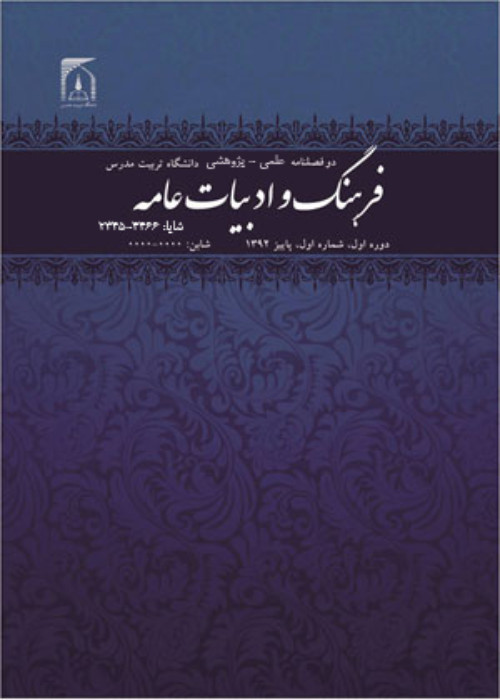The Representation of the Role of Women in Qajar Era Literature: A Home School Perspective
The purpose of this study is to investigate the status of women and their role in literature of Qajar era in classic religious schools. We have selected seventy fairy tales from popular folk tales in the Qajar era. The conceptual model of this research is a combination of literary and sociological theories as well as qualitative research method and content analysis. After reading the textual body and extracting the data, we used the conceptual model of the study to examine the actions of women in the stories. The aim was to explain the various roles of women in stories. The findings show that considering the predominance of masculine discourse and gender-biased mentality, the political and social role of women in stories is prominent and their cultural, educational, and legal roles are very limited. The rest of the womenchr('39')s roles are located these two maximum and minimum poles.
Karami and Hesampour (2005) have examined the image and position of women in the folk tales of Samak Ayar; Darabnameh. Bayat (2010) has analyzed the role and position of women in these stories by examining the heroes of forty Persian folk tales on the subject of love and marriage. Bagheri (2013) has studied the active and passive role of women in twenty-two stories focusing on the theme of heroism and Ayari, which comes from Samak Ayar in the classical period to Amir Arsalan Rumi in the Qajar era. Mohammad Hassani Lor and his colleagues (2016) have also investigated Kelileh and Demneh, Samak Ayar and Darabnameh to study the image of women in folk tales. A brief review of this background does not provide a comprehensive answer to the questions we consider in this study as our research is different in the text body, method, and type of variables.
Research objectives and questions
The main question of the article is: How are women represented in home school literature? Is this type of literature expressing the social reality of the Qajar era? The importance of this question becomes apparent when we know that classic religious schoolschr('39') literature became one of the most important factors in the socialization of children and adolescents, who later became men and women in the society. Zolfaghari and Heydari (2012) have published the literature of Iranian libraries during the Qajar period, which includes seventy poems and prose stories. Our textual body in the present article focuses on these seventy stories.
Data collection
In this study, we have examined the special role of women in the form of four social roles including the legal role in the family institution, the economic role, the political role, the educational role, and the cultural role.
The legal role of women in the family
Due to the courtly atmosphere in the stories, there is no cohesive family, but the woman has accepted the roles of child, wife, mother, and sister.
The study of child value is based on the issue of childbearing (the importance of the son or daughter) and the valuation of the daughter in the family institution. In most of these stories, the girl is miserable and unhappy. Due to the existence of polygamy and having a harem, a woman in the role of a wife is deprived of many of her natural rights, and equality in marriage is seen only in love affairs. The social class of the spouses is usually the same and the man is often higher. The wife has no identity; she is anonymous or marked with general and related letters such as shrine, so-and-so wife, family, so-and-so mother, etc. The woman in the role of mother is mostly a means of reproduction that disappears after the birth of a child and is replaced by a midwife (46 times a father and 16 times a mother). The honorable mother has only a moral and religious dimension. Using metaphors such as mother of the days, constellation, assemblage, universe, the woman carries the manifestation of guilt, error, and fall. The woman in the role of sister also has an active and effective presence next to her brother.
The role of women in the education system
Due to the very limited literacy in this respect, the educational role of women has been mentioned only in four stories (Kolsoomnaneh, Daleh and Mokhtar, Najma Shirazi and Bahramoghandam) as a religious teacher and letter writer.
Economic role
Gender discrimination and the ideology of the breadwinner and the housewife are prominent in the stories. Men have an economically active role by gaining superior social status and middle and inferior status, but women are more likely to engage in the economic activity in service roles (midwife, broker, maid) to meet the need for economic activity.
The cultural role of women
Culturally, a man is considered valuable (strong, a hero, and a protagonist) and a woman is considered worthless (weak, an object, a shrine, and a cunning). Devaluation includes psychological and verbal violence against women, which includes obscenity, descriptive and metaphorical interpretations of gender, general naming, and specific naming of instruments and norms such as the norm of violence against women (psychological and physical).
Political role
Women do not have a clear political role in the stories of the Qajar era, but their power and involvement in decision-making and their actions and reactions in order to survive and develop is a kind of hidden political activity: decision-making power in love, marriage, repelling the rival, saving the beloved, removing the obstacle, satisfying the sexual need (33 times) and using cunning to satisfy the need, repelling the calamity, achieving the desire and saving the life, property, honor and family (15 times). The use of magic has come for sexual, financial and revenge needs (13 times), and greed and domination (8 times).
The literature of the Qajar era home schools is a clear reflection of the ruling discourse and the patriarchal and sexist ideology that marginalized women as the other and the second sex. The study of the cultural and social dimensions of the role of women and their presence in stories, while highlighting the resistance of the bold and impudent women who are rejected by the patriarchal society, manifests the dominance of male power.
- حق عضویت دریافتی صرف حمایت از نشریات عضو و نگهداری، تکمیل و توسعه مگیران میشود.
- پرداخت حق اشتراک و دانلود مقالات اجازه بازنشر آن در سایر رسانههای چاپی و دیجیتال را به کاربر نمیدهد.



